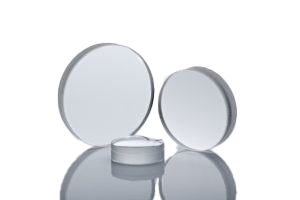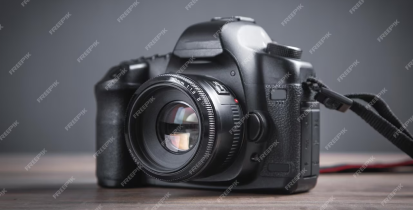

Stock Available
Bespoke Ordering Available
Contact us now
Find out more about our custom achromatic lenses
Call +44 (0)1622 859444 Call +1 401 583 7846
Knight Optical can provide custom achromatic lenses, both as doublets and triplets, manufactured to your specific requirements.
A prominent issue with single spherical lenses is the introduction of chromatic aberration, where the focal point varies for different wavelengths of light. However, this can be minimised by using an achromatic lens (an achromat) which consists of multiple elements – typically two lenses (a doublet) or three lenses (a triplet) manufactured from different glass types.
We can provide positive and negative focal lengths, and already stock a variety of achromatic doublet lenses ranging from 4mm to 110mm in diameter. Knight Optical can also supply achromatic doublet lenses where infrared materials such as germanium, silicon and zinc selenide are used.
Knight Optical can also provide achromatic aspheric lenses where one of the surfaces is aspheric to further reduce chromatic and spherical aberration. The aspheric element can be polymer-based, making it a cost-effective solution, or using another glass type for more precision imaging.

Speak to our experts about your Custom Achromatic Lenses needs today
Call +44 (0)1622 859444 Call +1 401 583 7846Make a quick enquiry about Custom Achromatic Lenses Now
Dive into the forefront of optical solutions. Got questions about an optical product? Reach out now and let our expertise guide you.
Optical Properties of Achromatic Lenses
Our typical manufacturing capabilities can be found below, and a range of glass types are available including Schott (and equivalent) materials.
| Diameter | 3mm to 150mm+ |
|---|---|
| Centration | < 3 arc minutes |
| Surface Figure | < 1 fringe |
|---|---|
| Scratch/dig | < 60/40 |
Frequently Asked Questions
-
What is an achromatic doublet lens, and how does it work?
-
An achromatic doublet lens is a type of optical lens designed to correct chromatic aberration, a common issue where different wavelengths of light do not converge at the same point after passing through a lens. It consists of two lenses made from different types of glass—typically one positive (convex) lens and one negative (concave) lens—that are bonded together. This combination minimises the dispersion of light into its constituent colours, resulting in clearer images with reduced colour fringing.
-
What are the advantages of using an achromatic lens over a simple lens in optical systems?
-
Achromatic lenses offer several advantages over simple, single-element lenses. By significantly reducing chromatic aberration, they provide sharper and more accurate images. This is particularly beneficial in applications requiring high precision, such as microscopy, photography, and telescopic optics. Achromatic lenses also allow for better focus of multiple wavelengths of light, improving the effectiveness of optical instruments across various light conditions, including UV and visible spectrums.
-
How do I choose the right achromatic lens for my needs?
-
Choosing the right achromatic lens involves considering several factors, including the wavelength range you’re working with (e.g., UV, visible light), the optical system’s required aperture, focal length, and the level of chromatic and spherical aberration correction needed. For specialised applications, such as UV imaging or high-precision optics, you may require specific types of achromatic lenses, like UV achromatic or aspheric achromatic lenses, which provide enhanced performance and correction capabilities.
-
Can you explain the difference between aspheric and spherical achromatic lenses?
-
The primary difference between aspheric and spherical achromatic lenses lies in the shape of their surfaces. Spherical achromatic lenses have surfaces that are segments of a sphere, while aspheric achromatic lenses feature one or more surfaces that deviate from this spherical shape. Aspheric achromatic lenses are designed to further reduce spherical aberration in addition to chromatic aberration, providing even sharper and more accurate imaging, especially useful in complex optical systems or applications requiring high-resolution imaging.
-
What factors affect the price of an achromatic lens?
-
The price of an achromatic lens can vary widely based on several factors, including the quality of the materials used, the precision of the lens design and manufacturing, the size and focal length of the lens, and any specialised coatings or customisations. Generally, lenses designed for professional or scientific applications, especially those with larger diameters, longer focal lengths, or specialised coatings for UV applications, will be more expensive than standard achromatic lenses used in hobbyist or educational settings.
-
How is an achromatic doublet lens designed to minimise chromatic aberration?
-
The design of an achromatic doublet lens involves carefully selecting materials with different refractive indices and dispersion properties for the two lens elements. By doing so, the lens designer can ensure that two or more wavelengths of light are focused to the same point, effectively minimise chromatic aberration. The curvature of each lens surface is also precisely calculated to optimise the correction of chromatic and spherical aberrations, resulting in a lens that provides clear, accurate imaging across a range of wavelengths.
Is your question not here?
We are ready and waiting to answer any queries you may have about achromatic lenses.
Additional Information
Minimal Aberrations
Achromatic lenses are excellent for minimising both chromatic and spherical aberrations.
Wavelength Correction
They generally correct for blue and red light when used in visible wavelengths, which is achieved by using a concave high-index flint glass and a convex low-index crown glass.
Achromatic Triplets
There are two main achromatic triplet types, the Hastings triplet and the Steinheil triplet, both of which consist of a low-index element cemented between two high-index components. We can also supply apochromatic triplet lenses which correct for three wavelengths rather than two (red, blue and green). These are widely used in photography where the designation ‘APO’ is used. Often a fluoride element is used, using materials such as calcium fluoride.
Optical Coating
An optical coating can be applied to your achromatic lens to enhance its performance. Typically an antireflective (AR) coating is applied which is optimised for a broadband wavelength range.
Capabilities
Available Stock

Get in touch with us:
With our in-house state-of-the-art metrology laboratory you can be confident that your optical components will meet your requirements. You can find out more about our testing facilities here.

Operating for over 30 years
Knight Optical has been operating for over 30 years, with our managing director Colin Overton at the helm. Over this time, we have become a global leader in the production and distribution of scientific optical components and bringing quality into focus for all of our products and services that we provide.
Our 2022/2023 Catalogue
Inside Knight Optical’s catalogue you’ll find details of the industries we serve as well as the many other services we can offer. It also showcases hundreds of our most popular products, supported by useful technical information, to help you choose the right part for your application.
Click below to view our digital catalogue now.



